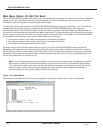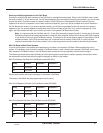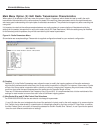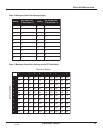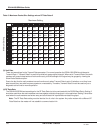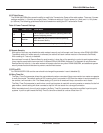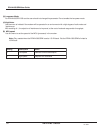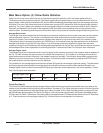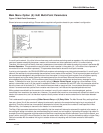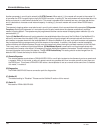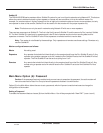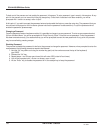
DATA-LINC GROUP
36
PN 161-09981-002C
rev 8/04
DDAA1000/SRM User Guide
Another parameter in a multi-point network is (4) DTR Connect. When set at (1), the remote will connect to the master if it
is free when the DTR line goes high on the 9-pin RS232 connector. In setting (2), the radio modem will accumulate data in its
buffer and transmit in a burst when the buffer is full. This mode is valuable when a network has many low data rate devices
and it is desirable to increase overall network capacity. In setting (0), the radio modem will transmit when RS232 data is
received.
The repeater’s hopping pattern must also be set in a multi-point network; this is accomplished with parameter (5) Repeater
Frequency. Setting this parameter is in contrast with point-to-point mode where the repeater automatically uses the
master’s hopping pattern. The repeater may be programmed to either use the master’s hopping pattern selection (0) or its
own selection (1).
Option (6) NetWork ID allows multi-point networks to be established without the use of the Call Book. If the NetWork ID is
set to any value lower than the default (255), the remotes in the multi-point network will communicate with the first multi-
point master or repeater heard with the same NetWork ID. When the NetWork ID is used, multi-point masters and repeaters
may be replaced without reprogramming all of the remotes in the network. In addition, this allows a remote to establish
communications with different masters (though not at the same time) without having the call book numbers in the Call Book.
This is very useful in mobile multi-point applications. (8) MultiMaster Synch is reserved for multi-point applications with
concentrations of master units where it is necessary to reduce interference between the masters. Please contact the factory
for more information on the use of this feature. The (9) 1PPS Enable/Delay This setting should not be changed from its
default of 255. Contact the factory for further information.
(A) Remote/Repeater
The remote/repeater mode allows a DDAA1000/DD1000 in a multi-point system to simultaneously act as a remote and
a repeater. When in this mode, a radio will repeat transmit any packets sent from a master as well as send them out
the RS232 port. This allows a DDAA/DD1000 set as a slave/repeater to act as a remote at the same time. 0 disables
this mode, 1 enables it.
(B) Diagnostics
The DDAA1000/DD1000 has no connection point for diagnostics.
(C) SubNet ID
The default setting is “Disabled.” Please see the SubNet ID section of this manual.
(D) Radio ID
Not used for DDAA1000/DD1000.





